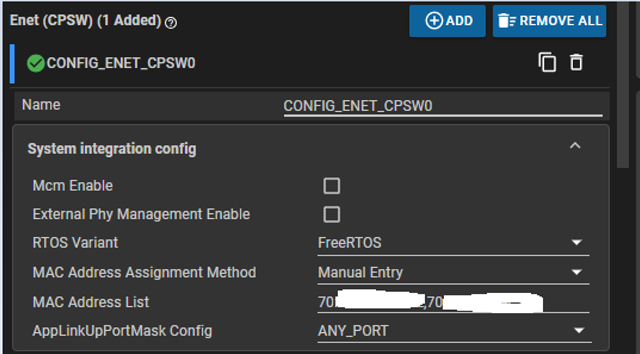Other Parts Discussed in Thread: SYSCONFIG
Tool/software:
Hi,
Originally EVM test on Ethernet loopback test was working fine until the I2C device 0x50 (Board_ID EEPROM) was tested with writing large file (128KB) and after
the Ethernet loopback test fails as shown in the attached when ti_board_config.c fails to get the maximum number of MAC addresses at line 287
#define ENET_BOARD_NUM_MACADDR_MAX (4U)
EnetAppUtils_assert(ENET_GET_NUM_MAC_ADDR(numMacMax) <= ENET_BOARD_NUM_MACADDR_MAX);
and the test is hanged right here.
Just wonder if the I2C device holds the ethernet MAC addresses in some of the memory block inside the I2C device or not.
Before that large file write/read test to I2C device, the smaller file (6KB) was conducted and the ENET loopback was still working OK.
After the write/read test large data file to I2C, the ENET loopback fails as shown above for 4 different examples :
A53 (Mac end loopback and PHY end loopback)
R5F (Mac end loopback and PHY end loopback)
Here is the error :
MAIN_Cortex_R5_0_0: ============================
MAIN_Cortex_R5_0_0: Enet Loopback : Iteration 1
MAIN_Cortex_R5_0_0: ============================
MAIN_Cortex_R5_0_0: CPSW_3G Test
MAIN_Cortex_R5_0_0: Enabling clocks!
MAIN_Cortex_R5_0_0: Assertion @ Line: 287 in syscfg/ti_board_config.c: ENET_GET_NUM_MAC_ADDR(numMacMax) <= ENET_BOARD_NUM_MACADDR_MAX : failed !!!
Note that switch to the new 64EVM board the ENET loopback on 4 examples is running OK with 5 iterations. However; with the new board
I refrain from running I2C write/read test with large file. Running I2C test with smaller data file is OK and ENET loopback is still working.
The question is where the routine get the MAC addresses from ?
Any hint/help to get the ENET test running again for the bad board is much appreciated.
Thanks,
Huynh


